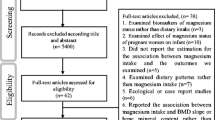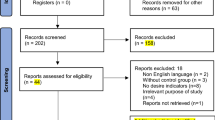Abstract
Summary
The meta-analysis suggested that dietary vitamin C was statistically inversely associated with the risk of hip fracture (overall OR = 0.73, 95% CI = 0.55–0.97, I 2 = 69.1%) and with the increase of 50 mg/day vitamin C intake, the risk of hip fracture will reduce by 5% (OR = 0.95, 95% CI 0.91–1.00, P = 0.05).
Introduction
Previous studies had inconsistent findings regarding the association between vitamin C intake and the risk of hip fracture. Therefore, we conducted a meta-analysis to evaluate the association of dietary vitamin C intake and the risk of hip fracture.
Methods
Relevant studies were identified by searching PubMed, Embase, and Web of Science up to December 2016. Additional articles were identified from reviewing the reference lists of relevant articles. The summary relative risks (RRs) or odds ratios (ORs) and 95% confidence intervals (CIs) were estimated by random effects model. Funnel plot and Egger’s test were used to test publication bias.
Results
The total six articles containing 7908 controls and 2899 cases of hip fracture were included in this meta-analysis. By comparing the highest versus the lowest categories of vitamin C intake, we found that dietary vitamin C was statistically correlated with the risk of hip fracture [overall OR = 0.73, 95% CI = 0.55–0.97, I 2 = 69.1%]. A linear dose-response association showed that the increase with vitamin C intake of 50 mg/day statistically reduced by 5% (OR = 0.95, 95% CI 0.91–1.00, P = 0.05) the risk of hip fracture.
Conclusions
In conclusion, the results of current meta-analysis strongly support that increasing dietary vitamin C intake can decrease the risk of hip fracture. In order to verify the association of vitamin C intake and hip fracture risk, further well-designed largely randomized controlled trials (RCTs) are needed.




Similar content being viewed by others
References
Johnell O, Kanis JA (2006) An estimate of the worldwide prevalence and disability associated with osteoporotic fractures. Osteoporos Int 17(12):1726–1733. https://doi.org/10.1007/s00198-006-0172-4
Burge R, Dawson-Hughes B, Solomon DH, Wong JB, King A, Tosteson A (2007) Incidence and economic burden of osteoporosis-related fractures in the United States, 2005–2025. J Bone Miner Res 22(3):465–475. https://doi.org/10.1359/jbmr.061113
Polidori MC, Pientka L, Nelles G, Griffiths HR (2010) Modulation of cholesterol in midlife affords cognitive advantage during ageing—a role for altered redox balance. Int J Clin Exp Med 3(2):103–109
Feola M, Rao C, Tempesta V, Gasbarra E, Tarantino U (2015) Femoral cortical index: an indicator of poor bone quality in patient with hip fracture. Aging Clin Exp Res 27:S45–S50. https://doi.org/10.1007/s40520-015-0423-3
Kanis JA (1994) Assessment of fracture risk and its application to screening for postmenopausal osteoporosis: synopsis of a WHO report. WHO Study Group. Osteoporos Int 4(6):368–381
Cooper C, Campion G, Melton LJ 3rd (1992) Hip fractures in the elderly: a world-wide projection. Osteoporos Int 2(6):285–289
Niu JJ, Shen MJ, Meng B, Yang Y, Yang HL (2014) Percutaneous kyphoplasty for the treatment of osteoporotic thoracolumbar fractures with neurological deficit: radicular pain can mimic disc herniation. Int J Clin Exp Med 7(8):2360–2364
Benetou V, Orfanos P, Pettersson-Kymmer U, Bergstrom U, Svensson O, Johansson I, Berrino F, Tumino R, Borch KB, Lund E, Peeters PH, Grote V, Li K, Altzibar JM, Key T, Boeing H, von Ruesten A, Norat T, Wark PA, Riboli E, Trichopoulou A (2013) Mediterranean diet and incidence of hip fractures in a European cohort. Osteoporos Int 24(5):1587–1598. https://doi.org/10.1007/s00198-012-2187-3
Aghajanian P, Hall S, Wongworawat MD, Mohan S (2015) The roles and mechanisms of actions of vitamin C in bone: new developments. J Bone Miner Res 30(11):1945–1955. https://doi.org/10.1002/jbmr.2709
Hie M, Tsukamoto I (2011) Vitamin C-deficiency stimulates osteoclastogenesis with an increase in RANK expression. J Nutr Biochem 22(2):164–171. https://doi.org/10.1016/j.jnutbio.2010.01.002
Park JK, Lee EM, Kim AY, Lee EJ, Min CW, Kang KK, Lee MM, Jeong KS (2012) Vitamin C deficiency accelerates bone loss inducing an increase in PPAR-gamma expression in SMP30 knockout mice. Int J Exp Pathol 93(5):332–340. https://doi.org/10.1111/j.1365-2613.2012.00820.x
Pradel W, Mai R, Gedrange T, Lauer G (2008) Cell passage and composition of culture medium effects proliferation and differentiation of human osteoblast-like cells from facial bone. J Physiol Pharmacol 59(Suppl 5):47–58
Urban K, Hohling HJ, Luttenberg B, Szuwart T, Plate U, Biomineralisation Research U (2012) An in vitro study of osteoblast vitality influenced by the vitamins C and E. Head Face Med 8:25. https://doi.org/10.1186/1746-160X-8-25
Simon JA, Hudes ES (2001) Relation of ascorbic acid to bone mineral density and self-reported fractures among US adults. Am J Epidemiol 154(5):427–433. https://doi.org/10.1093/aje/154.5.427
Sahni S, Hannan MT, Gagnon D, Blumberg J, Cupples LA, Kiel DP, Tucker KL (2009) Protective effect of total and supplemental vitamin C intake on the risk of hip fracture—a 17-year follow-up from the Framingham Osteoporosis Study. Osteoporosis Int 20(11):1853–1861. https://doi.org/10.1007/s00198-009-0897-y
Sahni S, Hannan MT, Gagnon D, Blumberg J, Cupples LA, Kiel DP, Tucker KL (2008) High vitamin C intake is associated with lower 4-year bone loss in elderly men. J Nutr 138(10):1931–1938
Morton DJ, Barrett-Connor EL, Schneider DL (2001) Vitamin C supplement use and bone mineral density in postmenopausal women. J Bone Miner Res 16(1):135–140. https://doi.org/10.1359/jbmr.2001.16.1.135
Kim YA, Kim KM, Lim S, Choi SH, Moon JH, Kim JH, Kim SW, Jang HC, Shin CS (2015) Favorable effect of dietary vitamin C on bone mineral density in postmenopausal women (KNHANES IV, 2009): discrepancies regarding skeletal sites, age, and vitamin D status. Osteoporos Int 26(9):2329–2337. https://doi.org/10.1007/s00198-015-3138-6
Kim DE, Cho SH, Park HM, Chang YK (2016) Relationship between bone mineral density and dietary intake of beta-carotene, vitamin C, zinc and vegetables in postmenopausal Korean women: a cross-sectional study. J Int Med Res 44(5):1103–1114. https://doi.org/10.1177/0300060516662402
Kaptoge S, Welch A, McTaggart A, Mulligan A, Dalzell N, Day NE, Bingham S, Khaw KT, Reeve J (2003) Effects of dietary nutrients and food groups on bone loss from the proximal femur in men and women in the 7th and 8th decades of age. Osteoporos Int 14(5):418–428. https://doi.org/10.1007/s00198-003-1391-6
Zhang J, Munger RG, West NA, Cutler DR, Wengreen HJ, Corcoran CD (2006) Antioxidant intake and risk of osteoporotic hip fracture in Utah: an effect modified by smoking status. Am J Epidemiol 163(1):9–17. https://doi.org/10.1093/aje/kwj005
Michaelsson K, Holmberg L, Mallmin H, Sorensen S, Wolk A, Bergstrom R, Ljunghall S (1995) Diet and hip fracture risk: a case-control study. Study Group of the Multiple Risk Survey on Swedish Women for Eating Assessment. Int J Epidemiol 24(4):771–782
Stroup DF, Berlin JA, Morton SC, Olkin I, Williamson GD, Rennie D, Moher D, Becker BJ, Sipe TA, Thacker SB (2000) Meta-analysis of observational studies in epidemiology: a proposal for reporting. Meta-analysis Of Observational Studies in Epidemiology (MOOSE) group. JAMA 283(15):2008–2012
Finck H, Hart AR, Lentjes MAH, Jennings A, Luben RN, Khaw KT, Welch AA (2015) Cross-sectional and prospective associations between dietary and plasma vitamin C, heel bone ultrasound, and fracture risk in men and women in the European Prospective Investigation into Cancer in Norfolk cohort. Am J Clin Nutr 102(6):1416–1424. https://doi.org/10.3945/ajcn.115.111971
Melhus H, Michaelsson K, Holmberg L, Wolk A, Ljunghall S (1999) Smoking, antioxidant vitamins, and the risk of hip fracture. J Bone Miner Res 14(1):129–135. https://doi.org/10.1359/jbmr.1999.14.1.129
Nieves JW, Grisso JA, Kelsey JL (1992) A case-control study of hip fracture: evaluation of selected dietary variables and teenage physical activity. Osteoporos Int 2(3):122–127
Sun LL, Li BL, Xie HL, Fan F, Yu WZ, Wu BH, Xue WQ, Chen YM (2014) Associations between the dietary intake of antioxidant nutrients and the risk of hip fracture in elderly Chinese: a case-control study. Br J Nutr 112(10):1706–1714. https://doi.org/10.1017/S0007114514002773
Hartling L, Milne A, Hamm MP, Vandermeer B, Ansari M, Tsertsvadze A, Dryden DM (2013) Testing the Newcastle Ottawa Scale showed low reliability between individual reviewers. J Clin Epidemiol 66(9):982–993. https://doi.org/10.1016/j.jclinepi.2013.03.003
Mantel N, Haenszel W (1959) Statistical aspects of the analysis of data from retrospective studies of disease. J Natl Cancer Inst 22(4):719–748
Begg CB, Mazumdar M (1994) Operating characteristics of a rank correlation test for publication bias. Biometrics 50(4):1088–1101
Egger M, Davey Smith G, Schneider M, Minder C (1997) Bias in meta-analysis detected by a simple, graphical test. BMJ 315(7109):629–634
Larsson SC, Orsini N, Wolk A (2010) Vitamin B6 and risk of colorectal cancer: a meta-analysis of prospective studies. JAMA 303(11):1077–1083. https://doi.org/10.1001/jama.2010.263
Hong Z, Tian C, Zhang X (2012) Dietary calcium intake, vitamin D levels, and breast cancer risk: a dose-response analysis of observational studies. Breast Cancer Res Treat 136(1):309–312. https://doi.org/10.1007/s10549-012-2172-8
Wu W, Kang S, Zhang D (2013) Association of vitamin B-6, vitamin B-12 and methionine with risk of breast cancer: a dose-response meta-analysis. Br J Cancer 109(7):1926–1944. https://doi.org/10.1038/bjc.2013.438
Fairfield KM, Fletcher RH (2002) Vitamins for chronic disease prevention in adults: scientific review. JAMA 287(23):3116–3126
Garrett IR, Boyce BF, Oreffo RO, Bonewald L, Poser J, Mundy GR (1990) Oxygen-derived free radicals stimulate osteoclastic bone resorption in rodent bone in vitro and in vivo. J Clin Invest 85(3):632–639. https://doi.org/10.1172/JCI114485
Jehle S, Hulter HN, Krapf R (2013) Effect of potassium citrate on bone density, microarchitecture, and fracture risk in healthy older adults without osteoporosis: a randomized controlled trial. J Clin Endocrinol Metab 98(1):207–217. https://doi.org/10.1210/jc.2012-3099
Iwamoto J, Sato Y, Takeda T, Matsumoto H (2009) High-dose vitamin K supplementation reduces fracture incidence in postmenopausal women: a review of the literature. Nutr Res 29(4):221–228. https://doi.org/10.1016/j.nutres.2009.03.012
Carpenter TO, DeLucia MC, Zhang JH, Bejnerowicz G, Tartamella L, Dziura J, Petersen KF, Befroy D, Cohen D (2006) A randomized controlled study of effects of dietary magnesium oxide supplementation on bone mineral content in healthy girls. J Clin Endocrinol Metab 91(12):4866–4872. https://doi.org/10.1210/jc.2006-1391
Acknowledgments
We gratefully acknowledge the support of the National Natural Science of China (81372679 and 81673165).
Author information
Authors and Affiliations
Corresponding author
Ethics declarations
Conflicts of interest
None.
Rights and permissions
About this article
Cite this article
Sun, Y., Liu, C., Bo, Y. et al. Dietary vitamin C intake and the risk of hip fracture: a dose-response meta-analysis. Osteoporos Int 29, 79–87 (2018). https://doi.org/10.1007/s00198-017-4284-9
Received:
Accepted:
Published:
Issue Date:
DOI: https://doi.org/10.1007/s00198-017-4284-9




